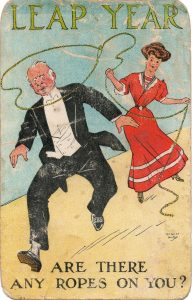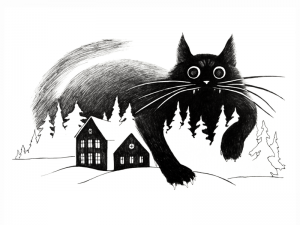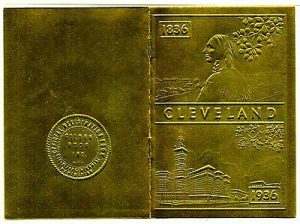
Historically, subversion has often been a central aspect of holiday celebrations. The Roman festival of Saturnalia, for instance, saw slaves treated to lavish banquets and given license to disrespect their masters for the day. Christmastime festivities in England involved the seasonal appointment of a peasant or lowly sub-deacon as the “Lord of Misrule,” elevated beyond his station and charged with overseeing Christmas revelries. Similar traditions in the Middle Ages entailed designating a “boy bishop” to parody the actual bishop during occasions such as the feast of the Holy Innocents.
Leap Day — February 29 — has its own history of holiday subversion, in this case dealing specifically with gender roles. Throughout Europe and even in parts of the United States, Leap Day has involved flipping the script typically adhered to during the rest of the year when it comes to courtship in particular.
One such tradition involved women proposing to men (February 29 being referred to as “Bachelor’s Day”). The custom seems to originate in the British Isles. According to one account,
[I]t is said that the tradition began in 5th century Ireland when St. Brigid of Kildare bitterly complained to St. Patrick that women had to wait far too long for men to propose.
The legend says that St. Patrick decreed the women could propose on this one day in February during the leap year.
This tradition took a different form in three Illinois cities. For much of the twentieth century, Aurora, Joliet, and Morris, Illinois “replaced city council members, police, and firefighters with women on February 29. But the women had only one real objective: finding a husband.” Vox.com illustrates the day with a newspaper account from 1932:
Guilty, pleaded Mr John Livingston, a popular United States airman, when he was arraigned at the police court at Aurora, Illinois, on a charge that while he was the town’s most eligible bachelor he refused to marry the police magistrate, Miss Florence Atkins.
Your honour is beautiful, but I have maintained my plea of guilty, said Mr Livingston as he awaited sentence.
Miss Atkins, passing sentence, said: In accordance with the old Leap Year custom. I must fine you. You are ordered to buy me a new silk dress.
The prisoner was then released and under the care of the dark eyed Chief of Police, Miss Dorothy Ward, was taken to a shop to make the purchase.
Sadly — or perhaps not so sadly, given their sexist overtones — traditions like these have largely been forgotten. Perhaps it is time to establish a new set of Leap Day observances instead. The most promising alternative might be found in 30 Rock’s Leap Day episode (Season 6, Episode 9), in which “the cast and writers celebrate Leap Day with a Santa Claus-like mascot, a gilled creature named Leap Day William, who lives in the Mariana Trench and trades candy for children’s tears.”








